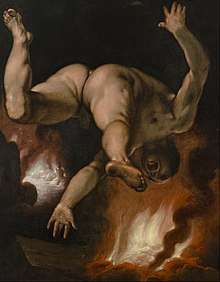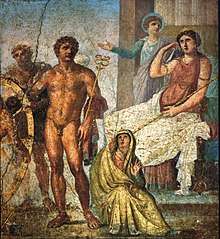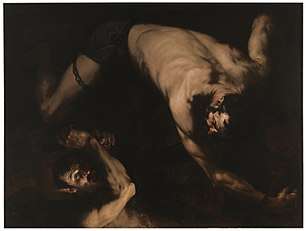Ixion
| Ixion | |
|---|---|
| King of the Lapiths | |
 The Fall of Ixion by Cornelis van Haarlem | |
| Abode | in the valley of the Peneus and on the mountain Pelion in Thessaly |
| Personal information | |
| Consort | Dia and Nephele |
| Children | Peirithoös by Dia, Centaurs or Centaurus (Greek mythology) by Nephele |
| Parents | son of Ares, or Leonteus, or Antion and Perimele, or Phlegyas |
| Siblings | Coronis |
In Greek mythology, Ixion (/ɪkˈsaɪ.ən/ ik-SY-ən;[1] Greek: Ἰξίων, gen.: Ἰξίωνος means "strong native"[2]) was king of the Lapiths, the most ancient tribe of Thessaly, and a son of Ares, or Leonteus, or Antion and Perimele, or the notorious evildoer Phlegyas, whose name connotes "fiery". Peirithoös[3] was his son (or stepson, if Zeus were his father, as the sky-god claims to Hera in Iliad 14).[4]
Background

Ixion married Dia,[5] a daughter of Deioneus (or Eioneus) and promised his father-in-law a valuable present. However, he did not pay the bride price, so Deioneus stole some of Ixion's horses in retaliation. Ixion concealed his resentment and invited his father-in-law to a feast at Larissa. When Deioneus arrived, Ixion pushed him into a bed of burning coals and wood. These circumstances are secondary to the fact of Ixion's primordial act of murder; it could be accounted for quite differently: in the Greek Anthology (iii.12), among a collection of inscriptions from a temple in Cyzicus is an epigrammatic description of Ixion slaying Phorbas and Polymelos, who had slain his mother, Megara, the "great one".[6]
Ixion went mad, defiled by his act; the neighboring princes were so offended by this act of treachery and violation of xenia that they refused to perform the rituals that would cleanse Ixion of his guilt (see catharsis). Thereafter, Ixion lived as an outlaw and was shunned. By killing his father-in-law, Ixion was reckoned the first man guilty of kin-slaying in Greek mythology. That alone would warrant him a terrible punishment.
However, Zeus had pity on Ixion and brought him to Olympus and introduced him at the table of the gods. Instead of being grateful, Ixion grew lustful for Hera,[7] Zeus's wife, a further violation of guest-host relations. Zeus found out about his intentions and made a cloud in the shape of Hera, which became known as Nephele (from nephos "cloud") and tricked Ixion into coupling with it. From the union of Ixion and the false-Hera cloud came Centauros, who mated with the Magnesian mares on Mount Pelion, Pindar told,[8] engendering the race of Centaurs, who are called the Ixion from their descent.
Ixion was expelled from Olympus and blasted with a thunderbolt. Zeus ordered Hermes to bind Ixion to a winged fiery wheel that was always spinning. Therefore, Ixion is bound to a burning solar wheel for all eternity, at first spinning across the heavens,[9] but in later myth transferred to Tartarus.[10] Only when Orpheus played his lyre during his trip to the Underworld to rescue Eurydice did it stop for a while.

Analysis
"The details are very odd, the narrative motivation creaks at every juncture," observes Robert L. Fowler;[11] "the myth smacks of aetiology." He notes that Martin Nilsson suggested[12] an origin in rain-making magic, with which he concurs: "In Ixion's case the necessary warning about the conduct of magic has taken the form of blasphemous and dangerous conduct on the part of the first officiant."
In the fifth century, Pindar's Second Pythian Ode (ca. 476-68 BCE) expands on the example of Ixion, applicable to Hiero I of Syracuse, the tyrant of whom the poet sings; and Aeschylus, Euripides and Timasitheos each wrote a tragedy of Ixion: none have survived.
Ixion was a figure also known to the Etruscans, for he is depicted bound to the spoked wheel, engraved on the back of a bronze mirror, ca 460-450 BCE, in the British Museum.[13] Whether the Etruscans shared the Ixion figure with Hellenes from early times or whether Ixion figured among those Greek myths that were adapted at later dates to fit the Etruscan world-view is unknown. The figure on the mirror-back is shown as winged, a characteristic shared with Etruscan daimones and Underworld figures rather than human heroes.

In literature
- In Chapter 22 of Charles Dickens' David Copperfield, Steerforth declares: "As to fitfulness, I have never learnt the art of binding myself to any of the wheels on which the Ixions of these days are turning round and round."[14]
- In the Epilogue to Moby-Dick, Ishmael, the only surviving crewmember at the sinking of the Pequod, likens himself to "another Ixion."[15]
- In Guillaume Apollinaire's poem Vendémiaire, "...open-air chimneys impregnate the clouds/As once did the mechanical Ixion" (“... cheminées à ciel ouvert engrossent les nuées/Comme fit autrefois l’Ixion mécanique”) [16]
- In Lord Byron's satiric poem Don Juan: Dedication, "Not even a sprightly blunder's spark can blaze / From that Ixion grindstone's ceaseless toil, / That turns and turns to give the world a notion / Of endless torments and perpetual motion."[17]
- In John Keats's epic poem Hyperion, the Goddess Thea's power is such that it can 'sta[y] Ixion's wheel' (Book 1, 30).
See also
Notes
- ↑ The Latin transcription, Ixīōn, shows that the stress should be on the second syllable.
- ↑ Robert Graves. The Greek Myths, section 50 s.v. Asclepius
- ↑ Peirithoös, too slew a kinsman, which occasioned his own wandering in search of catharsis.
- ↑ "come, let us turn to lovemaking. For never did such desire for goddess or woman ever flood over me, taming the heart in my breast, not even when I loved Ixion's wife, who bore Peirithoös, the gods' equal in counsel..." Tactless, Zeus lists several more of his conquests to Hera.
- ↑ Dia "is only another name for Hebe, the daughter of Hera, and indeed was probably the name for Hera herself, as 'she who belongs to Zeus' or 'the Heavenly one'" (Kerenyi 1951:159).
- ↑ The more familiar Megara of myth is not the same figure.
- ↑ He was already wedded to her double, Dia.
- ↑ Pindar, Second Pythian Ode.
- ↑ The meticulous Pindar mentions the feathers.
- ↑ Kerenyi 1951:160
- ↑ Fowler, "The myth of Kephalos as aition of rain-magic (Pherekydes FrGHist 3F34)", Zeitschrift für Papyrologie und Epigraphik 97 (1993:29–42).
- ↑ Nilsson, The Mycenaean Origin of Greek Mythology (1931) p.135 note 19.
- ↑ BM GR 1900.6-11.3, illustrated in Larissa Bonfante and Judith Swaddling, Etruscan Myths (series The Legendary Past, British Museum/University of Texas), 2006, p. 29 fig. 15; "On an Etruscan mirror, Ixion is shown spread-eagled to a firewheel, with mushroom tinder at his feet" (Graves 1960, §63.2) The wheel has been recognized as the solar wheel at least since Arthur Bernard Cook, Zeus: A Study in Ancient Religion, 1914, pp 197-98, and pl. XVII, the bronze Etruscan mirror engraved with Ixion on his wheel.
- ↑ "David Copperfield, by Charles Dickens". www.gutenberg.org. Retrieved 2017-05-01.
- ↑ Herman Melville (1851) [U.S. edition November 14, 1851]. "Epilogue". Moby-Dick. New York: Harper & Brothers. Retrieved June 5, 2014.
Round and round, then, and ever contracting towards the button-like black bubble at the axis of that slowly wheeling circle, like another Ixion I did revolve....
- ↑ Apollinaire, Guillaume (1913). "Vendémiaire". Alcools.
- ↑ "Don Juan: Dedication by Lord Byron (George Gordon)". Poetry Foundation. 2017-04-30. Retrieved 2017-05-01.
Sources
Primary sources
- Pindar. Pythian Odes, II.21-48.
- The story of Ixion is also told by Pseudo-Apollodorus Epitome of the Bibliotheca, 1.20; Diodorus Siculus, 4.69.3-.5; Hyginus, Fabulae 33 (mention) and 62; Virgil in Georgics 4 and Aeneid 6, and by Ovid in Metamorphoses 12.
- Lucian of Samosata, Dialogues of the Gods (On-line text in English)
Secondary sources
- Graves, Robert, (1955) 1960. The Greek Myths, Section 63 passim.
- Kerenyi, Karl. The Gods of the Greeks. London: Thames & Hudson, 1951 (pp. 158–160).
External links
| Wikimedia Commons has media related to Ixion. |